Did you know the clavicle or collarbone, is one of the most frequently broken bones in the human body?
Collarbones play a crucial role in shoulder and arm mobility. It connects the shoulder blades to the breastbone and supports the arms.
Whether you’re recovering from a collarbone injury or want to improve your shoulder health, it is important to maintain flexibility and strength in the muscles and joints around the collarbone area.
It improves posture and shoulder alignment, increases arm and shoulder mobility, tones your collarbone, and reduces tightness or pain in the upper back and neck.
I’ll provide 15 effective exercises targeting the collarbone and surrounding shoulder muscles in this post.

- Anatomy of the Collarbone and Surrounding Areas
- 10 Best Collarbone Strengthening Exercises
- 1. Shoulder Shrugs
- 3. Push Ups
- 4. Shoulder Press
- 6. Resistance Band Pull Apart
- 6. Plank Shoulder Taps
- 7. Dumbbell Lateral Raise
- 8. Chest Press
- 9. Dumbbell Fly
- 10. Scapula Push-Ups
- Stretching and Flexibility Exercises for the Collarbone Area
- 11. Wall slides
- 12. Foam Rolling
- 13. YTWL Exercises
- 14. Shoulder Blade Squeeze
- 15. Doorway Chest Stretch
- Conclusion
Anatomy of the Collarbone and Surrounding Areas
The collarbone, or clavicle, is a long, slender bone that lies horizontally at the base of the neck.
Each clavicle curves slightly, creating a sort of ‘S’ shape, and extends from the sternum (breastbone) to the acromion of the scapula (shoulder blade).
It helps keep the shoulder stable and supported. The collarbone also protects vital nerves and blood vessels that run beneath it to the neck and arms.
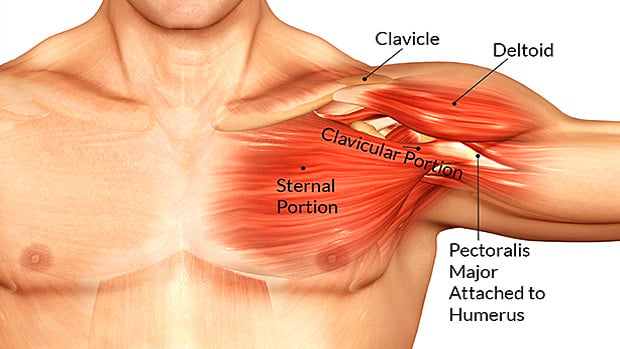
The main muscles surrounding the clavicle are:
- Pectoralis major — the large fan-shaped chest muscle
- Deltoids — This thick, triangular muscle covers the shoulder joint.
- Trapezius — the triangle-shaped muscle between the neck and upper back
These muscles work together with the clavicle to allow the arms to move in multiple planes of motion.
10 Best Collarbone Strengthening Exercises
The collarbone area is often overlooked, but it can be strengthened and toned with the right exercises to make it look better.
Try these 10 best collarbone exercises to keep your shoulders strong and stable.
1. Shoulder Shrugs
Shoulder shrugs are a simple yet effective exercise that strengthens the shoulders, upper back, and neck muscles. Shrug can help reduce pain and discomfort by strengthening these muscles.
It specifically targets the upper trapezius muscle. It is located at the top of your back and is responsible for shoulder elevation, neck support, and a strong collarbone.
You can do shoulder shrugs with dumbbells, barbells, or resistance bands.
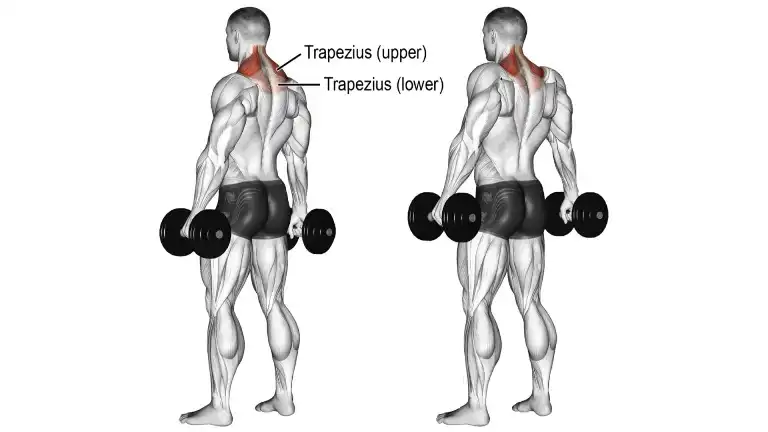
How to Do Dumbbell Shrug
- Stand straight with your feet shoulder-width apart.
- Hold a dumbbell in each hand with your arms hanging by your sides.
- Lift your shoulders towards your ears as high as possible, keeping your arms straight.
- Hold this elevated position for a moment.
- Gently lower your shoulders back to the starting position.
- Do 10–15 reps and 3–4 sets.
Tips And Form
- Avoid rolling your shoulders forward or backward.
- Focus on lifting your shoulders straight up towards your ears.
- Inhale when you lower the weight and exhale when you lift.
2. Upright Row
If you want to increase shoulder, collarbone, and upper back strength, look no further than the upright row.
The upright row is an exercise that targets the posterior chain muscles, including the shoulders and upper back.
Research shows that the upright row is one of the best exercises for building shoulder strength and stability.
Here are seven different ways to do an upright row using different equipment.
- Barbell Upright Row
- Dumbbell Upright Row
- Cable Upright Row
- One-Arm Dumbbell Upright Row
- Smith Machine Upright Row
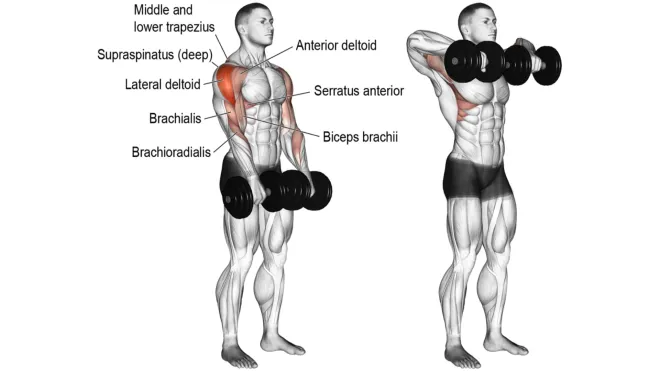
How To Do Dumbbell Upright Row
- Stand with your feet shoulder-width apart.
- Hold a dumbbell in each hand with an overhand grip (palms facing your body).
- Keep your arms extended, and let the dumbbells hang in front of your thighs.
- Lift the dumbbells by raising them vertically towards your upper chest.
- When lifting, focus on keeping the dumbbells close to your body and squeezing your shoulder blades together.
- Once the dumbbells reach the top of the movement, pause briefly for a peak contraction.
- Slowly lower the dumbbells back to the starting position.
Tips And Form
- Remember to exhale while you exert.
- Keep a controlled motion and avoid jerky movements.
- Keep your back straight and core engaged.
3. Push Ups
Push-ups are a classic bodyweight exercise that engages multiple muscle groups in the upper body, including the chest, shoulders, triceps, and the muscles around the collarbone.
Requires no special equipment and can be performed anywhere.
There are many ways to do push-ups, including different foot positions and angles. The most common ones are:
Beginners can start with knee push-ups or inclined push-ups. Advanced individuals can try variations like diamond push-ups or decline push-ups.
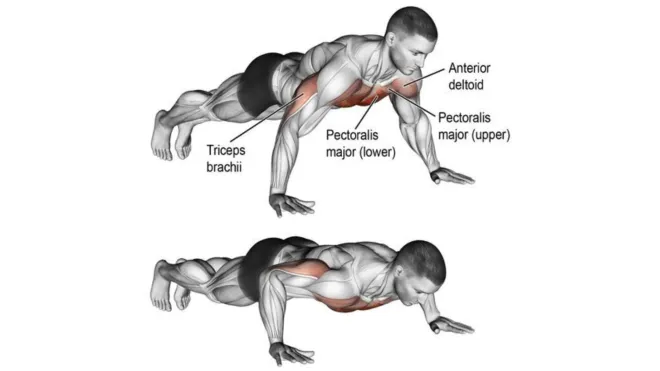
How To Do Push-Ups
- Start in a high plank position with your hands slightly wider than shoulder-width apart.
- Engage your core, squeeze your glutes, and maintain a neutral spine.
- Lower your body towards the ground by bending your elbows while keeping them close to your sides.
- Pause for a moment at the bottom position.
- Then, push through your palms, straightening your arms, and returning to the starting position.
- Repeat for the desired number of repetitions
Tips And Form
- Avoid sagging your hips or hiking your buttocks up.
- Keep your elbows at a 45-degree angle to your body to reduce stress on the shoulder joints.
4. Shoulder Press
The shoulder press is an effective exercise for strengthening and toning the shoulder and collarbone area.
It is a compound exercise that works multiple muscles in the upper body, including the deltoids, triceps, and trapezius.
It is a versatile exercise that can be done with dumbbells, barbells, or a machine.

How To Do Dumbbell Shoulder Press
- Sit or stand with your back straight.
- Hold a dumbbell in each hand at shoulder height, elbows bent, and palms facing forward.
- Press the weights up until your arms are fully extended above your head.
- Slowly lower the dumbbell back to the starting position at shoulder height.
- Perform a set number of repetitions, typically 8-12, depending on your fitness level and goals.
Tips And Form
- Keep your back straight and avoid arching your lower back.
- Keep elbows under wrists when lowering the weights.
6. Resistance Band Pull Apart
This movement can be done on shoulder day, as it targets the rear delts. However, I also like to hit it on a back day as the rear delts often need to double the weekly work.
The bands pull apart will work your rhomboids, rear delts, and traps. It’s a great shoulder and upper back exercise.
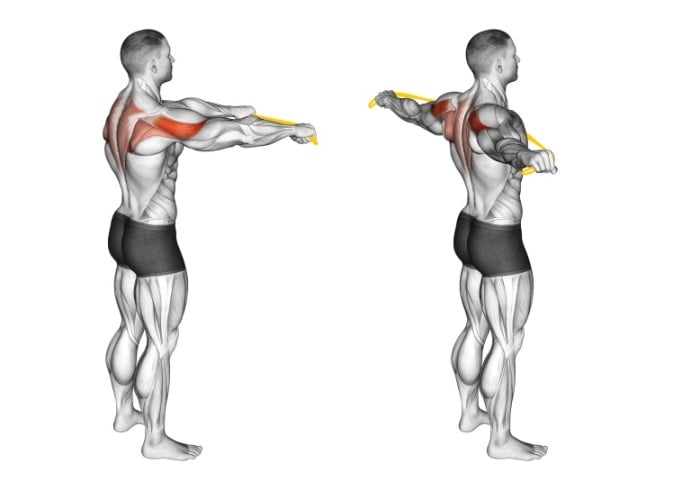
How To Do Resistance Band Pull Apart
- Stand with your feet shoulder-width apart, and keep a slight knee bend.
- Hold the exercise band in front of you with your hands slightly lower than your shoulders.
- Keep your elbows slightly soft to avoid hyperextending the joint.
- Squeeze the shoulder blades together and open the arms out to either side, pulling the band apart and squeezing your rhomboids.
- Return to start and repeat, keeping tension on the band the entire time.
- Repeat the desired number of reps.
Tips And Form
- Focus on really contracting your upper back muscles. Squeeze and hold once you reach the peak contraction, then slowly return to the starting position.
- Keep your core engaged throughout each set.
- Keep your elbows up so you can work your upper back muscles.
6. Plank Shoulder Taps
The plank shoulder tap is an advanced plank variation that works the core, glutes, arms, wrists, and shoulders. It is a great exercise for improving core strength, coordination, and balance.
This exercise helps to reduce lower back pain, improves your posture and flexibility, and tightens your midsection.
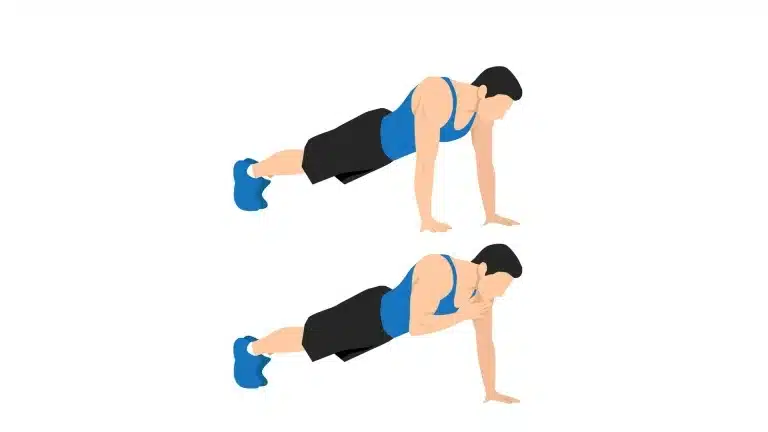
How To Do Plank Shoulder Tap
- Start in a plank position with your forearms on the ground and your elbows directly under your shoulders.
- Keep your body in a straight line from your head to your heels.
- Engage your core muscles and lift your right hand off the floor. Then tap your right shoulder.
- Return your right hand to the starting position and repeat with your left hand.
- Continue alternating sides for the desired number of repetitions.
Tips And Form
- Don’t let your back arch or your hips sag.
- Keep the neck neutral and avoid dropping the chin towards the chest.
Know More: Plank Exercise: Benefits, Variations, Muscles Worked, How To Do And Tips
7. Dumbbell Lateral Raise
Dumbbell Lateral Raise is a simple yet effective exercise that can help you target the shoulders, particularly the lateral or middle deltoid muscles.
This exercise is great for strengthening the shoulder and should be included in your collarbone workout routine.

How To Do The Dumbbell Lateral Raise
- Stand with your feet shoulder-width apart.
- Hold the dumbbells in each hand with your arms by your sides.
- Slowly lift the dumbbells to your sides, with your elbows slightly bent and your palms facing down.
- Continue lifting until your arms are parallel to the floor or slightly higher.
- Then, pause for a moment to feel the tension in your shoulders.
- Slowly lower the dumbbells back to the starting position.
- Repeat for the desired number of repetitions, typically around 10-12.
Tips And Form
- Keep your elbows slightly bent throughout the movement.
- Keep your core engaged and your upper body stable.
8. Chest Press
The chest press is a strength training exercise that primarily targets the pectoral muscles (chest), as well as the triceps, shoulders, and, to some extent, the muscles near the collarbone.
It can be performed using various equipment, such as a chest press machine, dumbbells, or a barbell.
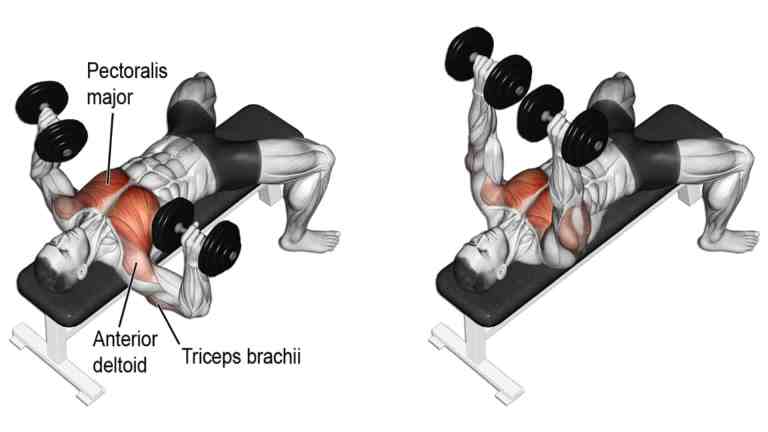
How To Do Dumbbell Bench Press
- Lie flat on a bench with your feet firmly planted on the floor.
- Hold a dumbbell in each hand, with your palms facing forward.
- Slowly extend your arms and push the dumbbells above your chest while exhaling.
- Pause for a moment at the top of the movement.
- Then, slowly lower the dumbbells back down towards your chest while inhaling.
- Do 2 to 3 sets of 8 to 15 repetitions
Tips And Form
- Don’t allow the dumbbells to collide at the top of each rep – bouncing them together may cause you to lose stability within the shoulder and injure yourself.
- Keep a controlled motion and avoid jerky movements.
- Maintain more tension through the pecs by not locking out the elbows entirely.
9. Dumbbell Fly
The dumbbell fly is a chest isolation exercise that is usually performed after big compound lifts, such as the Barbell press and incline bench press.
The move involves the rotator cuff, the back of the shoulders, and the serratus anterior, a muscle along the ribs that helps keep your shoulders in proper alignment.
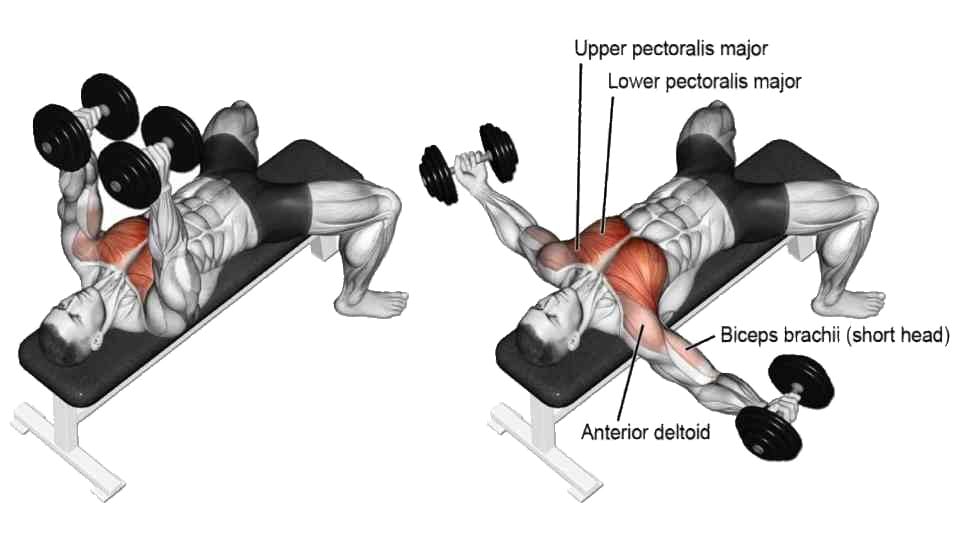
How To Do Dumbbell Chest Fly
- Lie flat on a bench with your feet firmly planted on the ground.
- Hold a dumbbell in each hand with a neutral grip (palms facing each other).
- Slowly lower the dumbbells out to the sides in a wide arc while maintaining a slight bend in your elbows.
- Keep lowering the dumbbells until your arms are parallel to the ground or slightly below the ground.
- Pause for a moment at the bottom of the movement.
- Now, slowly lift the dumbbells back up to where you started lifting them.
Tips And Form
- Don’t let your elbows drop too far.
- Don’t let the dumbbells touch as they meet at the top.
- Start with a light set of dumbbells if you’re a beginner, and slowly increase the weight each week as you build strength.
10. Scapula Push-Ups
Scapula Push-Ups are among the best exercises for strengthening the upper back muscles and improving shoulder strength and mobility.
The scapula push-up is known for being an advanced variation of the traditional push-up. It is also often recommended for people who want to improve their shoulder mobility, core strength, and stability.
If you want to make it easier, place your hands on a wall or do scapular push-ups on your knees.

How To Do Scapula Push Up
- You should get in the standard push-up position.
- Keep a neutral spine, tuck your chin, and put your elbows under your shoulders.
- Do not allow your neck to shoot forward or your lower back to cave in.
- Keep your arms straight and retract your shoulder blades by pulling them back and together and squeezing them at the top of the movement.
- Keep your arms straight and protract your shoulder blades by pushing them away from each other. Pause again.
Tips And Form
- Keep your back in a straight line and without bending your elbows.
- Use a small range of motion, and don’t lower your chest all the way to the floor.
Stretching and Flexibility Exercises for the Collarbone Area
Tight chest, neck, and shoulder muscles can limit the range of motion and cause poor posture over time.
Be sure to mix collarbone exercises with some key stretches that stretch the muscles around the clavicles, open up the chest, and improve shoulder flexibility.
These exercises help loosen and make the collarbone area more flexible.
11. Wall slides
Scapular wall slides are one of the basic exercises to improve shoulder rotation, upper back activation, and scapular mobility.
Working out this muscle group helps keep your collarbone strong and healthy.
The study found that the group that did wall slide exercises significantly decreased pain in the rotator cuff muscles after four weeks.
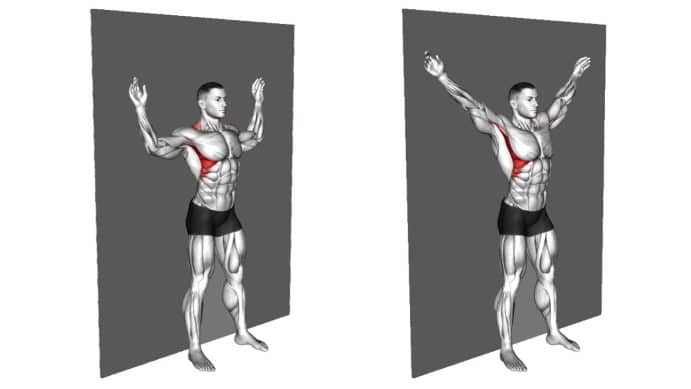
How To Do Wall Slide
- Start by standing with your back flat against a wall.
- Leave a slight bend in your knees so your legs aren’t fully locked.
- Slowly slide your arms up the wall until your arms are above your shoulders and 90 degrees from your torso.
- With your chest open and back tall, squeeze the muscles of your midback as you slide your arms down toward your shoulders.
- Keep your back and the backs of your palms, wrists, and elbows pressed up against the wall.
- Slowly slide your arms down the wall. Elbows are slightly lower than shoulder height.
12. Foam Rolling
Foam rolling is a self-myofascial release technique that uses a foam roller to apply pressure to specific body areas.
The pressure helps release muscle and fascia tension, improving mobility and reducing pain.
The study found that foam rolling effectively decreased the presence of adhesions, leading to improved muscle function and range of motion
There are several techniques for foam rolling the shoulders and back:
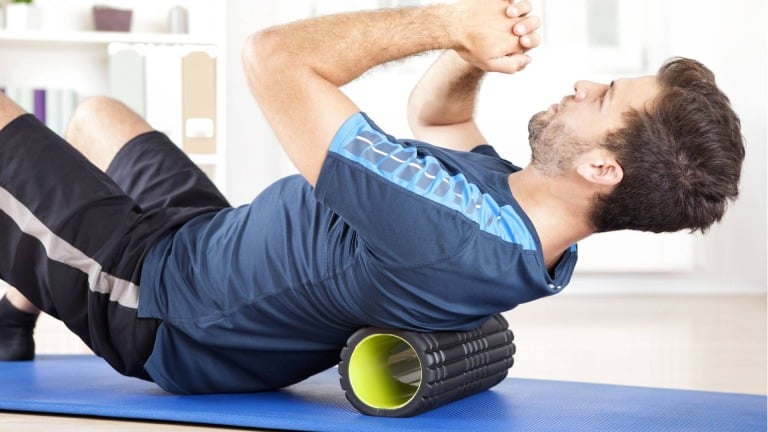
How To Do Upper Back Foam Roll
- Lay on your back with your knees bent, placing your hands behind the back of your head or in front of you, with the foam roller below your shoulder blades.
- Lift your hips off the floor and slowly push through your heels to move back and forth from your mid-back to the top of your shoulder blades.
- Keep your spine and head aligned in a neutral position.
- When you find a sore spot, stop and hold the position for at least 10–30 seconds until you can feel the muscle relax.
Tips And Form
- Avoid rolling directly on your spine or lower back.
- Keep your abs engaged to support your lower back and avoid overarching.
- Breathe deeply and slowly to help relax your muscles and release tension.
13. YTWL Exercises
These exercises focus on the shoulder and back muscles, mainly the middle and lower part of the trapezius.
They also hit all the rotator cuff muscles, including the infraspinatus, subscapularis, teres minor, and supraspinatus muscles.
These work together to stabilize the shoulder and move the arm. It is essential to include these exercises in your trap workout regimen.
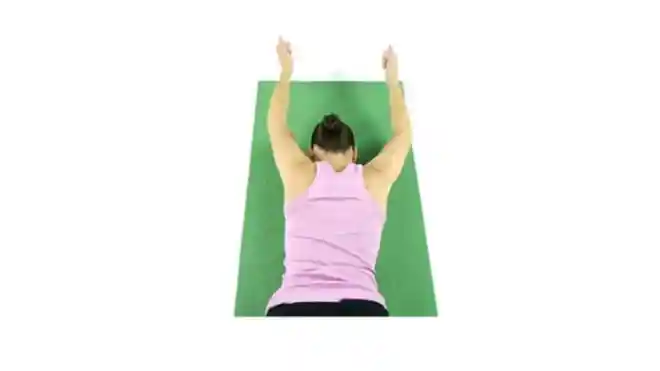
How To Do Prone I
- Gently exhale and slowly lift your arms off the floor (maintain a formation of the letter “I”), with palms facing inward.
- Keep your head aligned with your thoracic (upper) spine.
- Focus on using your shoulders to generate most of the lift, although some low back extension (arching) is acceptable.
Know More: Bodyweight Trap Exercises That You Can Do At Home Without Equipment
14. Shoulder Blade Squeeze
Shoulder blade squeeze, also known as scapular squeeze, is an exercise that focuses on strengthening the muscles responsible for retracting the shoulder blades.
It primarily targets the upper back muscles, including the rhomboids and middle trapezius.
Shoulder blade squeeze helps prevent rounded shoulders and improve posture by strengthening the muscles that pull the shoulder blades back.
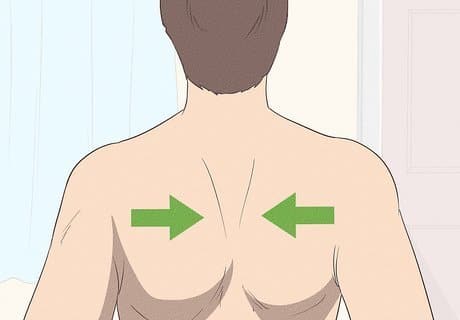
How To Do Shoulder Blade Squeeze
- Start by sitting or standing upright with good posture.
- Relax your arms by your sides.
- Gently squeeze your shoulder blades together by retracting them towards your spine.
- Imagine pinching a pencil or holding a small object between your shoulder blades.
- Hold the squeeze for a few seconds while maintaining good posture.
- Relax and repeat the movement for the desired number of repetitions.
Tips
- Concentrate on engaging the muscles between your shoulder blades
- While performing the exercise, try to keep your neck and other muscles as relaxed as possible.
15. Doorway Chest Stretch
The Doorway Chest Stretch is a simple and effective stretch targeting the chest muscles (pectorals), the muscles around the shoulders, and those near the collarbone.
It Can help alleviate tension and tightness in the chest and shoulder region.
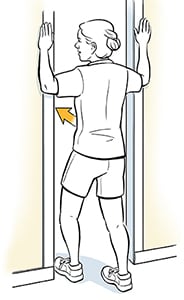
How To Do Doorway Chest Stretch
- Stand in a doorway and lift your arm to parallel the floor.
- Bend your elbow so your forearm is flat against the door frame, creating a 90-degree angle at the elbow.
- Gently lean forward until you feel a stretch in the front of your shoulder and across your chest.
- Keep your back straight and avoid arching your lower back.
- Hold the stretch for 20–30 seconds, breathing deeply and evenly.
- Repeat the stretch 2–3 times on each side.
Conclusion
Collarbone exercises can provide numerous benefits, including a more prominent collarbone, improved upper body strength, posture improvement, shoulder stability, and improved range of motion.
These exercises target various muscles in the upper body, including the pectoralis major, deltoids, trapezius, and rotator cuff muscles.
Incorporate these collarbone exercises into your routine and confidently embrace your natural beauty.
References
- Andersen CH, Andersen LL, Gram B, Pedersen MT, Mortensen OS, Zebis MK, Sjøgaard G. Influence of frequency and duration of strength training for effective management of neck and shoulder pain: a randomised controlled trial. Br J Sports Med. 2012 Nov;46(14):1004-10. doi: 10.1136/bjsports-2011-090813. Epub 2012 Jun 29. PMID: 22753863; PMCID: PMC3596862.

Manish brings over 10 years of hands-on experience in weight lifting and fat loss to fitness coaching. He specializes in gym-based training and has a lot of knowledge about exercise, lifting technique, biomechanics, and more.
Through “Fit Life Regime,” he generously shares the insights he’s gained over a decade in the field. His goal is to equip others with the knowledge to start their own fitness journey.
